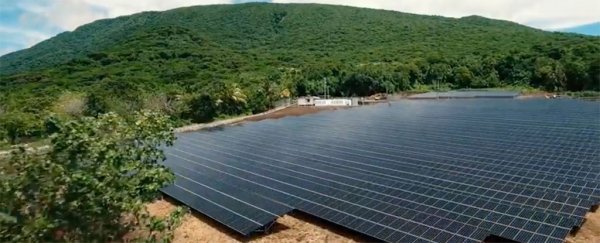Tesla has announced their solar panels are nearly entirely powering the island of Ta'u in American Samoa.
The island used to depend entirely on imported diesel fuel for its electricity, but a new initiative has seen the islanders build a 1.4-megawatt microgrid that absorbs and stores solar power for all their energy needs.
Ta'u is one of five main islands in the South Pacific that make up American Samoa, and is located more than 7,000 kilometres (4,350 miles) from the west coast of the US.
It's pretty isolated, and with a tiny population of less than 600 residents, Ta'u has historically relied on shipping for everything they can't grow, make, or otherwise produce on the island – including the fuel that powers their electricity system.
"I recall a time they weren't able to get the boat out here for two months," says Keith Ahsoon, a local resident whose family owns one of Ta'u's food stores.
"We rely on that boat for everything, including importing diesel for the generators for all of our electricity."
Each of those generators burn through some 1,135 litres (300 gallons) of fuel per day, amounting to approximately 414,500 litres (109,500 gallons) of diesel yearly – and that's not counting the energy costs of shipping fuel to Ta'u in the first place.
Now, thanks to a partnership between SolarCity and Tesla, an array of 5,328 solar panels – along with 60 Tesla Powerpacks (the industrial-grade version of the company's Powerwall batteries) – the islanders have been able to break their dependence on diesel imports for the first time.
The project, funded by the American Samoa Economic Development Authority, the Environmental Protection Agency, and the Department of Interior, kicked off operations this week, after being in construction for one year.
Tesla and SolarCity haven't disclosed exactly how much of Ta'u's electricity will now be provided by the microgrid, but a SolarCity blog post says it can supply "nearly 100 percent of the island's power needs".
Of course, it's easier and more practical to install a standalone solar system like this on a Sun-drenched island with a population under 600 than it would be in a large, denser and potentially much less sunny city like the ones most of us live in.
But the project still offers a tantalising glimpse of how we could unshackle ourselves from fossil fuels with the right clean energy infrastructure.
The system offers 6 megawatt hours of storage, meaning the island can stay powered for three full days without the sun shining – but when it does, the microgrid absorbs enough solar in just 7 hours of sunlight to top the Powerpacks back up to 100 percent capacity.
Provided sunny weather is constant enough, the microgrid will enable a much more consistent power supply than the rationing and outages Ta'u residents used to experience under their old fuel-based system.
"Once diesel gets low, we try to save it by using it only for mornings and afternoons," says Ahsoon. "It's hard to live not knowing what's going to happen. I remember growing up using candlelight."
Tesla and Solar City are currently installing an even bigger solar farm with almost 55,000 solar panels on the Hawaiian island of Kauai – and Tesla CEO Elon Musk has declared the companies intend to build hundreds more of these installations.
As far as Ahsoon is concerned, investing in clean energy over fossil fuel-based power is a step in the right direction.
"Living on an island, you experience global warming firsthand," he says. "Beach erosions and other noticeable changes are a part of life here. It's a serious problem, and this project will hopefully set a good example for everyone else to follow."
You can see a video explaining more about the project below:

